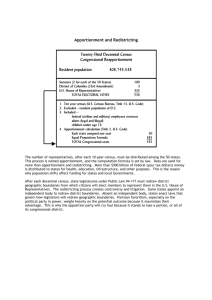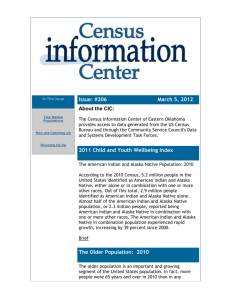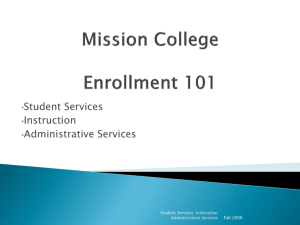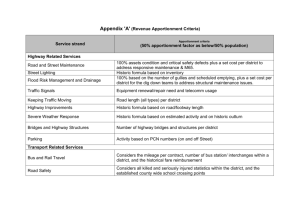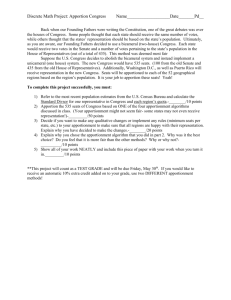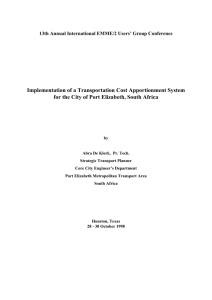Case Study
advertisement
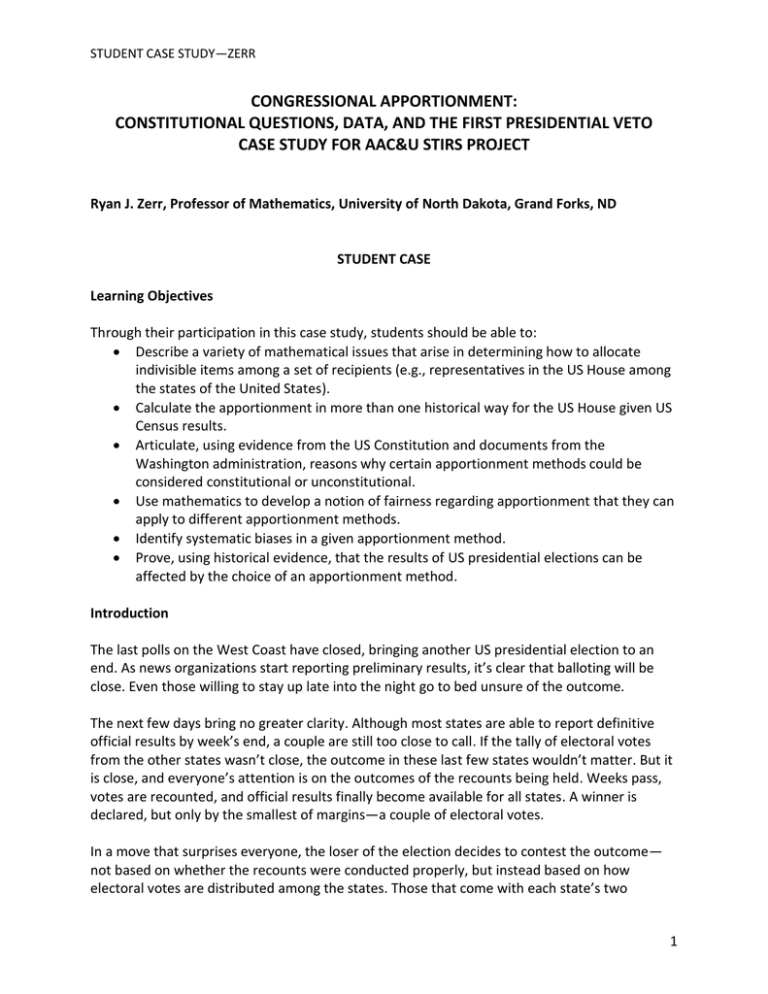
STUDENT CASE STUDY—ZERR CONGRESSIONAL APPORTIONMENT: CONSTITUTIONAL QUESTIONS, DATA, AND THE FIRST PRESIDENTIAL VETO CASE STUDY FOR AAC&U STIRS PROJECT Ryan J. Zerr, Professor of Mathematics, University of North Dakota, Grand Forks, ND STUDENT CASE Learning Objectives Through their participation in this case study, students should be able to: Describe a variety of mathematical issues that arise in determining how to allocate indivisible items among a set of recipients (e.g., representatives in the US House among the states of the United States). Calculate the apportionment in more than one historical way for the US House given US Census results. Articulate, using evidence from the US Constitution and documents from the Washington administration, reasons why certain apportionment methods could be considered constitutional or unconstitutional. Use mathematics to develop a notion of fairness regarding apportionment that they can apply to different apportionment methods. Identify systematic biases in a given apportionment method. Prove, using historical evidence, that the results of US presidential elections can be affected by the choice of an apportionment method. Introduction The last polls on the West Coast have closed, bringing another US presidential election to an end. As news organizations start reporting preliminary results, it’s clear that balloting will be close. Even those willing to stay up late into the night go to bed unsure of the outcome. The next few days bring no greater clarity. Although most states are able to report definitive official results by week’s end, a couple are still too close to call. If the tally of electoral votes from the other states wasn’t close, the outcome in these last few states wouldn’t matter. But it is close, and everyone’s attention is on the outcomes of the recounts being held. Weeks pass, votes are recounted, and official results finally become available for all states. A winner is declared, but only by the smallest of margins—a couple of electoral votes. In a move that surprises everyone, the loser of the election decides to contest the outcome— not based on whether the recounts were conducted properly, but instead based on how electoral votes are distributed among the states. Those that come with each state’s two 1 STUDENT CASE STUDY—ZERR senators are beyond dispute; but what about those that are apportioned based on each state’s number of Representatives in the House? The loser’s claim is that the apportionment was not done in a manner consistent with the US Constitution; if it had been, then she would be the next President of the United States. A Matter of Fairness No such challenge has ever been made to the outcome of a presidential election, but we need look no further into the past than the year 2000 to find an example of a close election, and there have been other similarly close elections throughout US history. What might have happened if there had been such a challenge? Would it really be legitimate, or borne only out of desperation? Is it really possible that an election’s outcome could hinge on this question? Although it may not seem so on the surface, the only way to fully understand these questions is to carefully consider the matter of fairness when dividing up something between different groups or individuals. What does it mean to divide or distribute something in a fair way? Does it always mean equal-sized pieces or allocations? Is that always realistic? Can a division of a resource, say, be fair even though not everyone receives the same amount? For something to be fair, do all parties need to agree that it’s fair, or is it enough that only some see it that way? The answers will likely depend on what’s being divided, and into how many pieces. For instance, if the “resource” is a peanut butter sandwich, which must be divided fairly between two brothers, then we might imagine the fair solution is to cut the sandwich into two equalsized pieces. But what if one brother made the sandwich, and therefore feels his effort deserves a larger piece? Would he see “equal” as “fair”? The point is that determining what’s fair may not always be simple. The peanut butter sandwich example illustrates a complexity that comes because opinions about fairness may differ—one brother sees equal as unfair. Not all disagreements about what is fair are borne out of differing opinions. In some situations, dividing things in an unfair way is inherent to the problem. It comes unavoidably from the nature of the resource or the requirements about how the division must occur. This case examines one such example. It’s an example that affects all who live in the United States—how to most equitably apportion the members of the US House of Representatives among the several states. The question seems a simple one at first: the more populous the state, the greater the number of representatives it will receive. But even basic examples quickly illustrate that in only the rarest of cases will a perfectly equitable solution be possible. In most realistic situations, including every instance encountered thus far throughout US history, every possible choice of apportionment method will result in an imperfect solution. A perfect solution in the spirit of “one person, one vote,” is almost always literally impossible. The difficulties inherent in finding the best choice from among imperfect solutions was confronted not long after the first US census in 1790. Different approaches emerged. The one originally adopted by Congress failed to meet President Washington’s expectations for 2 STUDENT CASE STUDY—ZERR constitutionality, resulting in the first-ever use of a presidential veto. And in wrestling with this apportionment question a situation was created that nearly resulted in a constitutional crisis 30 years later, at a time when passions were already running high over the expansion of slavery. This issue is not one with consequences relevant only for early US history. Is it possible that “fair” could be interpreted in ways different enough that some future election’s results might hinge on the distinction? The matter of how to answer these questions in the “best” way is important for helping ensure that the citizens of the future can have confidence in the integrity of the political system they inherit from us. Considering how to develop an apportionment using the Constitution and the 1790 census results will be the starting point for this case study, thus putting you in the shoes of the earliest members of Congress. By considering for yourself how this could be done, contrasting your approach with the competing proposals considered at the time, and examining each in light of President Washington’s veto, it is possible to develop an evidence-based understanding of how some of the founders viewed the constitutionality of various apportionment methods. This understanding will then be used to examine other approaches to apportionment, some of which have been adopted throughout US history. Ultimately you will be in a position to analyze the 2000 US presidential election. Might a different winner have emerged had a different apportionment method been in use at the time? Given that other close elections will occur in the future, what method would you recommend be used, and is there a mathematical basis for making such a determination? You will answer these and related questions as part of this case study. Philadelphia, Pennsylvania: Early 1792 The Situation Members of the 2nd US Congress have assembled and are about to consider the 1790 census results for the purposes of determining how many representatives each state will get in the next Congress. Your Task By considering the same information available to the members of the 2nd US Congress, develop a congressional apportionment. This will require you to determine how many Representatives each state should have in the House. Note that there are fifteen states, with Maine at the time still a part of Massachusetts (and thus Maine’s population must be included to ultimately calculate Massachusetts’s total). Documents to Use (see Appendices) US Constitution, Article I, Section 2 Census of Population and Housing, 1790 (US Census Bureau 1793, 4) What You Will Submit A document that contains at least the following information: 3 STUDENT CASE STUDY—ZERR A clear indication of how many total members should be in the House of Representatives, as well as a listing of how many of these will be apportioned to each of the fifteen states. A detailed description of how you arrived at your apportionment, including the calculations for at least two of the states (to help illustrate the process). Your description must meet the following two criteria: o It must be possible to apply to different census results. For example, it should be possible to use your method to determine an apportionment based on the 1800 US Census. o A classmate should be able to use the written description of your method to arrive at exactly the same apportionment that you did. A multi-paragraph description and defense of the decisions you made in developing your method. You should consider the question of fairness in defending your method, in particular trying to anticipate and respond to criticisms from those who might perceive your apportionment as unfair. Philadelphia, Pennsylvania: Early April 1792 The Situation Congress has just passed its first apportionment bill and sent it to President Washington. President Washington, before signing the bill, has asked the two principal members of his cabinet, Alexander Hamilton (Secretary of the Treasury) and Thomas Jefferson (Secretary of State), to provide their opinions. Your Task Read Congress’s first apportionment bill and the opinions by Hamilton and Jefferson to gain an understanding of how the situation was viewed at the time by key individuals in the government. Based on this understanding and the 1790 US Census results, compare the apportionments that would be arrived at based on Hamilton’s and Jefferson’s methods with the one passed by Congress. Documents to Use (see Appendices) An Act for an Apportionment of Representatives among the several States, according to the first Enumeration (US House Journal 1792, 565) Alexander Hamilton’s Input (Balinski and Young 1982, 16–17) Thomas Jefferson’s Input (Balinski and Young 1982, 18) What You Will Submit A document that contains at least the following information: A description of Hamilton’s apportionment method in your own words, accompanied by an application of his method to the 1790 Census results. Include enough of the details to make clear that you understand how Hamilton’s method is applied. Exactly the same as above, except for Jefferson’s apportionment method. 4 STUDENT CASE STUDY—ZERR A comparison between your apportionment results, Congress’s first bill, Hamilton’s apportionment, and Jefferson’s apportionment, which addresses each of the following: o Does your apportionment or Congress’s first apportionment meet either of Hamilton’s or Jefferson’s expectations? If so, was it arrived at in the same way (in other words, two different methods could yield the same apportionment, so the question here is whether or not the method used to arrive at an apportionment is the same as either of theirs)? o Do any of Congress’s, Hamilton’s, or Jefferson’s approaches seem unfair in any way? If so, how? Develop a mathematical way to quantify how fairly/unfairly each state is treated via each method. A multi-paragraph argument based on the information you’ve accumulated, in favor of one of the four possible apportionment approaches you’ve now considered (yours, Congress’s first apportionment bill, Hamilton’s approach, or Jefferson’s approach). You must make a choice and defend it, keeping in mind that Congress had to make a decision, and did therefore not have the option of avoiding the matter simply because no “perfect” solution seemed available. Philadelphia, Pennsylvania: April 5, 1792 The Situation President Washington has received and considered the apportionment bill passed by Congress, as well as the input he requested from his two cabinet members. He has decided to veto this bill, the first time this presidential authority has ever been used. Your Task Read President Washington’s veto message in order to understand his reasons for rejecting the first apportionment bill. Based on this, draft a different apportionment bill that will meet his interpretation of the Constitution. Documents to Use (see Appendix) Veto message from President Washington (US House Journal 1792, 563–64) US Constitution, Article I, Section 2 Census of Population and Housing, 1790 (US Census Bureau 1793, 4) What You Will Submit Before drafting an apportionment bill that will address President Washington’s concerns, it will be necessary to understand the precise nature of his two objections—both of which are mathematical in nature. It may help, especially for interpreting his first objection, to know that he followed Jefferson’s advice in deciding to veto the bill. The “proportion or divisor” referred to in the first objection is a number d that is used to calculate a state’s quota of representatives by using the formula q = p / d, 5 STUDENT CASE STUDY—ZERR where q is the state’s quota and p is the state’s population. Washington’s first objection is that no single value for d was used to determine all of the state apportionments in the vetoed bill. By algebraically rearranging the equation q = p / d, and, for each state, considering the range of quota values that would lead to that state’s apportionment under the first bill, determine the range of possible divisors that could have been used for each state. Use this information to confirm the claim made in Washington’s first objection. Provide a multi-paragraph summary of your work, making specific reference to relevant documents and including the calculations necessary to support your point. Now consider Washington’s second objection. Provide evidence that supports his claim, and identify the eight states to which he refers. Draft a new apportionment bill that, based on the two objections in his veto message, he would sign. In a couple of paragraphs, describe why your bill would satisfy his two concerns. Philadelphia, Pennsylvania: mid-April 1792 The Situation After receiving President Washington’s veto message, Congress reconsiders the apportionment question and passes a new apportionment bill that is subsequently signed into law. Your Task Read the second apportionment bill and understand its intent. By using a bit of mathematics, develop an evidence-based argument for whether this apportionment bill resulted in a fair or unfair way of dividing Representatives among the states. Documents to Use (see Appendices) Congress’s second apportionment bill (Annals of Congress 1792, 543–48) What You Will Submit A listing of the numbers of representatives each state received according to the bill signed by President Washington. Because the language in the bill seems a bit vague without any context, include a rationale for why you can be certain that your interpretation is correct. A position paper that addresses whether this apportionment was fair, keeping in mind that fair may mean different things to different people, and in different contexts. As part of your argument, be clear about how you interpret “fair” in a situation like this. For your paper you should quantify how fair each state’s apportionment is, and use this as part of your argument. Are there any systematic biases that lead to certain types of states being treated, in most cases, better or worse than others? Washington, DC: Mid 1842 The Situation 6 STUDENT CASE STUDY—ZERR The apportionment method accepted by President Washington has been in use now for 50 years. The only change has been, after each decennial census, to replace the divisor of 33,000 with larger and larger values (35,000 after 1810, 40,000 after 1820, and 47,700 after 1830) to prevent the House size from growing too much with the young country’s rapidly expanding population. But political wrangling after the 1840 Census has reached a point where divisor values are being proposed not in a rational way, but instead to score political points and to punish those from rival states. Daniel Webster, one of the day’s preeminent statesmen, had proposed an alternative apportionment method after the 1830 US Census that represented a clear break with the precedent established during Washington’s time (Balinski and Young 1982, 23–35). Although not adopted when initially proposed in the 1830s, Webster’s idea carries the day during the apportionment debates that follow the 1840 Census. Your Task To examine the Webster Method of Apportionment and the results from the apportionment bill obtained from it passed after the 1840 Census. Use your understanding of Washington’s notion of constitutionality to determine if this apportionment bill would have been considered constitutional. Mathematically assess the fairness of this new method. Documents to Use (see Appendices) Census of Population and Housing, 1840 (US Census Bureau 1841, 368) An Act For the apportionment of Representatives among the several States according to the sixth census, as amended by the Senate (H.R. 73, 27th Cong., 2d Sess., Bills and Resolutions, House of Representatives, 1842, 1–2; US House Journal 1842, 986–94) What You Will Submit Use the 1840 US Census results to carry out the apportionment according to the bill passed by Congress. As a check on your results, you should obtain a House size of 223 representatives. Briefly justify your interpretation of the bill. Using the documents and information that form the basis for this case study as well as your understanding of the situation, write a multi-paragraph argument that articulates why the 1842 apportionment act is constitutional. Using the documents and information that form the basis for this case study as well as your understanding of the situation, write a multi-paragraph argument that articulates why the 1842 apportionment act is unconstitutional. Interlude: Apportionment Methods Then and Now The Situation The change in approach to apportionment in 1842 was not the last. Most of the different approaches used throughout US history have involved what are called divisor methods. Both Jefferson’s Method and Webster’s Method are divisor methods. In these methods a divisor is chosen (for example, 33,000 for the 1790 Census results, or 70,680 for the 1840 Census results), and then the quota that results from dividing a state’s apportionment population by the divisor is rounded to an adjacent integer. In Jefferson’s Method the rounding is always 7 STUDENT CASE STUDY—ZERR down—effectively the fractional part of each state’s quota is simply disregarded. In Webster’s Method the rounding is done in the standard way: down if the fractional part is less than 0.5; up if it is 0.5 or greater. There have been decades when a non-divisor method has been used. However, most of the time Congress has decided to use a divisor method, with three such used at various points in US history: Jefferson’s Method: After 1790, 1800, 1810, 1820, and 1830 Webster’s Method: After 1840, 1900, 1910, 1930 Huntington-Hill Method: After 1940, 1950, 1960, 1970, 1980, 1990, 2000, 2010 Your Task To find information on the Huntington-Hill Method of apportionment and contrast its approach to rounding the fractional part of a state’s quota to the approaches used in the other two historical divisor methods. Articulate a mathematical rationale for why one of these three methods is fairer than the other two. Documents to Use (see Appendices) Census of Population and Housing, 1790 (US Census Bureau 1793, 4) What You Will Submit A one- to two-paragraph description of how the Huntington-Hill Method works, making sure to put your explanation in terms of how it rounds the fractional part of a state’s quota. A table containing the quotas for all fifteen states from the 1790 Census obtained from the divisor 33,000. By applying each of the Jefferson, Webster, and Huntington-Hill Methods, include the apportionments for each state in your table. Include a clear explanation for how you obtain the Huntington-Hill apportionment for each state. A multi-paragraph explanation, clearly rooted in mathematics, for why one of these methods could be considered to be bias-free, whereas the other two are inherently biased. Make clear how the two methods are biased (i.e., in favor of which types of states), and why the third method can be considered to be mathematically free of a systematic bias. Washington, DC: December 20XX The Situation After a hard-fought US presidential election, the electoral vote counts for the two principal candidates are incredibly close. However, one’s total exceeds the 270 necessary for a majority, and therefore she is declared the winner. Is it possible that this outcome would have changed had a different apportionment method been in use? Could something as basic as how fractional parts are rounded be the determining factor in a US presidential election? 8 STUDENT CASE STUDY—ZERR Your Task To determine if a US presidential election’s outcome can be affected by the choice of apportionment method. Documents to Use (see Appendices) 1990 Apportionment Results (US Census Bureau 1991) Many of the other historical documents used in this case study What You Will Submit A table containing the apportionment results for the 1990 Census using the Jefferson method, along with the corresponding Presidential Elector distribution. You should include the divisor that you used to obtain these results as well as the calculations for at least two of the states: one where the ideal apportionment is rounded down, and one where it is rounded up. It will be helpful to use a spreadsheet to automate the large number of calculations. You will also submit at least one of the following: A two- to three-page paper that supports the outcome from the 2000 presidential election. Your paper should use the information and understandings you have developed as part of this case study to support your position, including the alternative apportionment you obtained above. A two- to three-page paper that argues for an alternative outcome for the 2000 presidential election. Your paper should use the information and understandings you have developed as part of this case study to support your position. References Annals of Congress. 2nd Cong., 1st Sess. (April 1792), Apportionment Bill, House of Representatives, at 543–44 (1792), http://memory.loc.gov/cgibin/ampage?collId=llac&fileName=003/llac003.db&recNum=269. Balinski, Michel L., and H. Peyton Young. 1982. Fair Representation: Meeting the Ideal of One Man, One Vote. New Haven and London: Yale University Press. H.R. 73, 27th Cong., 2d Sess., Bills and Resolutions, House of Representatives, at 73 (1842), http://memory.loc.gov/cgi-bin/ampage?collId=llhb&fileName=027/llhb027.db&recNum=182. US Census Bureau. 1793. “Census of Population and Housing, 1790,” http://www.census.gov/prod/www/decennial.html. ———. 1841. “Census of Population and Housing, 1840,” http://www.census.gov/prod/www/decennial.html. ———.1991. “1990 Apportionment Results,” http://www.census.gov/population/apportionment/data/1990_apportionment_results.html. 9 STUDENT CASE STUDY—ZERR US House Journal, 2nd Cong., 1st Sess. (April 5, 1792), “President Washington’s Veto Message,” at 563–64 (1792), http://memory.loc.gov/cgibin/ampage?collId=llhj&fileName=001/llhj001.db&recNum=556&itemLink=D?hlaw:40:./temp/~ ammem_ws6f::%230010559&linkText=1. US House Journal, 2nd Cong., 1st Sess. (April 6, 1792), “An Act for an Apportionment of Representatives among the several States, according to the first Enumeration,” at 565 (1792), http://memory.loc.gov/cgibin/ampage?collId=llhj&fileName=001/llhj001.db&recNum=558&itemLink=D?hlaw:40:./temp/~ ammem_ws6f::%230010559&linkText=1. US House Journal, 27th Cong. 2nd Sess. (June 17, 1842), at 986–94 (1842), http://memory.loc.gov/cgibin/ampage?collId=llhj&fileName=037/llhj037.db&recNum=985&itemLink=D?hlaw:30:./temp/~ ammem_qFHi::%230370986&linkText=1. About the Author Ryan Zerr, professor of mathematics, has been at the University of North Dakota (UND) since 2003, after receiving his PhD in pure mathematics that same year from Iowa State University. Interested in pedagogical issues from the start, Zerr has engaged in a number of scholarly projects related to classroom practice, publishing work on topics ranging from the use of peer reviews in mathematical proof writing, to enhancing conceptual understanding in calculus, to the effectiveness of online homework for helping students to learn mathematics. Professor Zerr has a keen interest in general education and has been involved in UND’s general education program through service on various committees and task forces related to the revision, oversight, and assessment of the program. His interests in undergraduate education have also involved him in helping to develop a new first-year seminar program at UND, which he now coordinates. Within his department, Zerr currently serves as associate chair, and in that capacity functions as the instructional development coordinator for mathematics graduate teaching assistants. He also teaches a wide variety of courses, enjoying most those that help students see that mathematics is not really about memorizing and following rules or solution steps. Helping students become logical thinkers who can construct well-reasoned and evidence-based arguments—whether in the form of a mathematical proof, a project report, or an essay—is where he is most “at home” instructionally. It has been his good fortune to teach a course where these things can be situated, at least in part, in a historical context—another of his interests. It is at this confluence of history, mathematics, and evidence-based reasoning that his STIRS project resides. 10 STUDENT CASE STUDY—ZERR APPENDICES US Constitution, Article I, Section II The House of Representatives shall be composed of Members chosen every second Year by the People of the several States, and the Electors in each State shall have the Qualifications requisite for Electors of the most numerous Branch of the State Legislature. No person shall be a Representative who shall not have attained to the Age of twenty five Years, and been seven Years a Citizen of the United States, and who shall not, when elected, be an Inhabitant of that State in which he shall be chosen. Representatives and direct Taxes shall be apportioned among the several States which may be included within this Union, according to their respective Numbers, which shall be determined by adding to the whole Number of free Persons, including those bound to Service for a Term of Years, and excluding Indians not taxed, three fifths of all other Persons. The actual Enumeration shall be made within three Years after the first Meeting of the Congress of the United States, and within every subsequent Term of ten Years, in such Manner as they shall by Law direct. The Number of Representatives shall not exceed one for every thirty Thousand, but each State shall have at Least one Representative; and until such enumeration shall be made, the State of New Hampshire shall be entitled to chuse three, Massachusetts eight, Rhode-Island and Providence Plantations one, Connecticut five, New-York six, New Jersey four, Pennsylvania eight, Delaware one, Maryland six, Virginia ten, North Carolina five, South Carolina five, and Georgia three. When vacancies happen in the Representation from any State, the Executive Authority thereof shall issue Writs of Election to fill such Vacancies. The House of Representatives shall chuse their Speaker and other Officers; and shall have the sole Power of Impeachment. 11 STUDENT CASE STUDY—ZERR Census of Population and Housing, 1790 (US Census Bureau 1793, 4) 12 STUDENT CASE STUDY—ZERR An Act for an Apportionment of Representatives among the several States, according to the first Enumeration (US House Journal 1792, 565) Be it enacted by the Senate and House of Representatives of the United States of America in Congress assembled, That from and after the 3d day of March, in the year one thousand seven hundred and ninety-three, the House of Representatives shall be composed of one hundred and twenty members, elected within the Several states, according to the following apportionment; that is to say: Within the State of New Hampshire, five; within the State of Massachusetts, sixteen; within the State of Vermont, three; within the State of Rhode Island, two; within the State of Connecticut, eight; within the State of New York, eleven; within the State of New Jersey, six; within the state of Pennsylvania, fourteen; within the State of Delaware, two; within the State of Maryland, nine; within the State of Virginia, twenty-one; within the State of Kentucky, two; within the State of North Carolina, twelve; within the State of South Carolina, seven; within the State of Georgia, two. Jonathan Trumbull, Speaker of the House of Representatives John Adams, Vice President of the United States and President of the Senate. 13 STUDENT CASE STUDY—ZERR Alexander Hamilton’s Input to President Washington (Balinski and Young 1982, 16–17) (April 4, 1792) He now sends [his opinion] with his reasons but more imperfectly stated than he could have wished – through want of time. He has never seen the bill, but … he takes for granted that he cannot have misconceived its contents so as to cause any material error in the process of his reasoning … It is inferred from the provision of the Act – that the following process has been pursued: I. II. III. The aggregate numbers of the United States, are divided by 30,000, which gives the total number of representatives, or 120. This number is apportioned among the several states by the following rule – As the aggregate numbers of the United States are to the total number of representatives found as above, so are the particular numbers of each state to the number of representatives of such state. But As this second process leaves a residue of Eight out of the 120 members unapportioned, these are distributed among those states which upon that second process have the largest fractions or remainders. 14 STUDENT CASE STUDY—ZERR Thomas Jefferson’s Input to President Washington (Balinski and Young 1982, 18) (April 4, 1792) It will be said that, though, for taxes there may always be found a divisor which will apportion them among the States according to numbers exactly, without leaving any remainder, yet for representatives there can be no such common ratio, or divisor which, applied to the several numbers, will divide them exactly, without a remainder or fraction. I answer, then, that taxes must be divided exactly and representatives as nearly as the nearest ratio will admit; and the fractions must be neglected because the Constitution calls absolutely that there be an apportionment or common ratio, and if any fractions result from the operation, it has left them unprovided for. In fact it could not but foresee that such fractions would result, and it meant to submit to them. It knew they would be in favor of one part of the Union at one time and or another at another, so as, in the end, to balance occasional irregularities. But instead of such a single common ratio, or uniform divisor, as prescribed by the Constitution, the bill has applied two ratios, at least to the different States … And if two ratios be applied, then fifteen may, and the distribution becomes arbitrary … 120 being once found, in order to apportion them, we must recur to the former rule which does it according to the numbers of the respective States; and we must take the nearest common divisor, as the ratio of distribution, that is to say, that divisor which applied to every State, gives to them such numbers as, added together, come nearest to 120. 15 STUDENT CASE STUDY—ZERR President Washington’s Veto Message (US House Journal 1792, 563–64) United States [Philadelphia] April 5, 1792. Gentlemen of the House of Representatives: I have maturely considered the Act passed by the two Houses, intitled, ``An Act for an apportionment of Representatives among the several States according to the first enumeration,'' and I return it to your House, wherein it originated, with the following objections. First—The Constitution has prescribed that representatives shall be apportioned among the several States according to their respective numbers: and there is no one proportion or divisor which, applied to the respective numbers of the States will yield the number and allotment of representatives proposed by the Bill. Second—The Constitution has also provided that the number of Representatives shall not exceed one for every thirty thousand; which restriction is, by the context, and by fair and obvious construction, to be applied to the separate and respective numbers of the States: and the bill has allotted to eight of the States, more than one for thirty thousand. G. Washington. 16 STUDENT CASE STUDY—ZERR Congress’s Second Apportionment Bill (Annals of Congress 1792, 543–48): Apportionment of Representatives among the several States, according to the first Enumeration, [will occur] at the ratio of one for every thirty-three thousand persons, in the respective States. 17 STUDENT CASE STUDY—ZERR Census of Population and Housing, 1840 (US Census Bureau 1841, 368) 18 STUDENT CASE STUDY—ZERR An Act For the apportionment of Representatives among the several States according to the sixth census (Bills and Resolutions of the House and Senate 1842, 1-2) Be it enacted by the Senate and House of Representatives of the United States of America in Congress assembled, That, from and after the third day of March, one thousand eight hundred and forth-three, the House of Representatives shall be composed of members elected agreeably to a ratio of one Representative for every fifty thousand one hundred and seventy-nine persons in each State, computed according to the rule prescribed by the Constitution of the United States, that is to say: Within the State of Maine, ten; within the State of New Hampshire, five; within the State of Massachusetts, fourteen; within the State of Rhode Island, two; within the State of Connecticut, six; within the State of Vermont, five; within the State of New York, fortyeight; within the State of New Jersey, seven; within the State of Pennsylvania, thirtyfour; within the State of Delaware, one; within the State of Maryland, eight; within the State of Virginia, twenty-one; within the State of North Carolina, thirteen; within the State of South Carolina, nine; within the State of Georgia, eleven; within the State of Alabama, nine; within the State of Louisiana, five; within the State of Mississippi, five; within the State of Tennessee, fifteen; within the State of Kentucky, fourteen; within the State of Ohio, thirty; within the State of Indiana, thirteen; within the State of Illinois, nine; within the State of Missouri, seven; within the State of Arkansas, one; and within the State of Michigan, four. Sec. 2. And be it further enacted, That, in every case, when a State is entitled to more than one Representative, the number to which each State shall be entitled under this apportionment shall be elected by districts, composed of contiguous territory, equal in number to the number of Representatives to which said State may be entitled: no district electing more than one Representative. Passed the House of Representatives, May 3, 1842 Attest: M. S. Clarke, Clerk. 19 STUDENT CASE STUDY—ZERR Amendments made by the Senate to An Act For the apportionment of Representatives among the several States according to the sixth census (US House Journal 1842, 986–94) And the question was put, that the House do concur with the Senate in the first amendment to said bill, proposing to strike out the ratio of "50,179 persons," and to insert a ratio of "70,680 persons." And passed in the affirmative, Yeas, ... 113, Nays, ... 104. The question was then put, that the House do concur in the second amendment of the Senate to the said bill; which second amendment proposes to insert the words following: "And of one additional Representative for each State having a fraction greater than one moiety of the said ratio," And passed in the affirmative, Yeas, ... 110, Nays, ... 102. 20 STUDENT CASE STUDY—ZERR 1990 Apportionment Results (US Census Bureau 1991) 21
